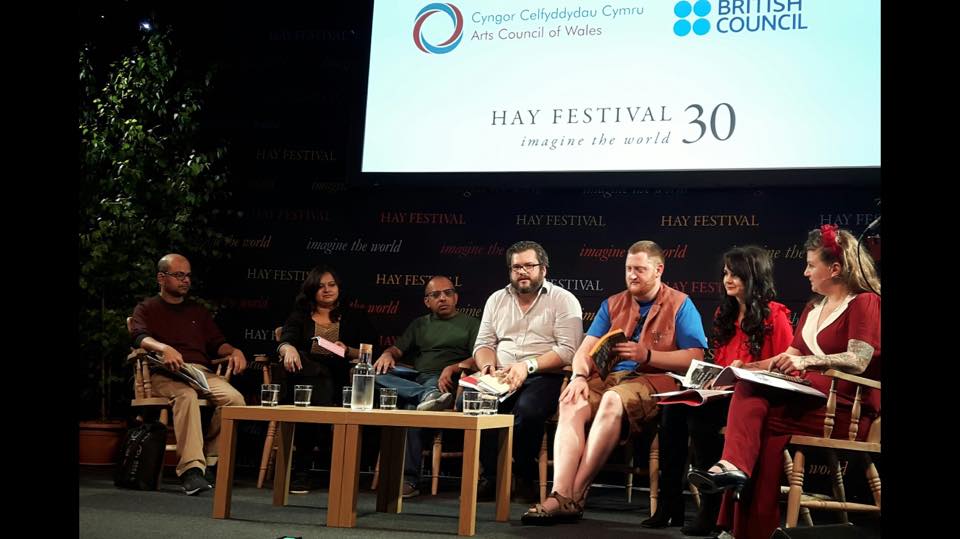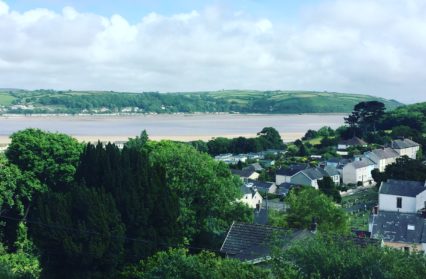Gary Raymond reflects on the emerging political context of the Valley, City, Village India/Wales project, and asks if Wales could be at the forefront of a working-class literary revolution, inspired by the bubble-bursting of Jeremy Corbyn.
It started on the eve on India’s 70th Republic Day in the rainy heat of New Delhi, and it ended in the chilled drizzle of Llansteffan in Carmarthenshire less than 24 hours after Theresa May lost her parliamentary majority in the UK’s General Election. The Valley, City, Village project (or VCV as it became known) may seem a relatively modest collaboration of writers in the shadow of these bold political bookends, but in truth such events came to represent something integral – to me at least – not just to the writing that would be produced through the project, but to the writers who took part. VCV was never intended to be a political project, and politics was never discussed in any depth in relation to its progress, but what became apparent over its course was that each writer had an innate political drive that was linked to the tumultuous goings on around us. In part this drive was conspicuous in the work, as I will explain, but overall these writers have come to represent something in themselves.
VCV was born from the British Council’s UK/India initiative, announced by David Cameron in 2012, to celebrate the cultural ties between the two nations in this milestone year. It was an arts project that every step of the way has been sensitive to overt political comment (a conscious decision but the project managers and by me as its editor), and yet had been ironically inspired by perhaps the most important political episode in the histories of either Britain or India. All art, as the saying goes, is political. And it is perhaps fitting that as the main phase of the project drew to a close in the drizzle of LLansteffan, that the politics implicit in the VCV became apparent, made luminous by Jeremy Corbyn’s success.
The original idea of the VCV was to bring together writers of Welsh and Bengali cultures in a tri-lingual collaboration, pushed together by the vision and enthusiasm of two publishers, Parthian from Wales and Bee Books from Kolkata, and various figures at the British Council, Wales Arts International and Literature Wales. Richard Davies, Parthian’s Director, and the lynchpin of much that has happened, came up with the idea to take the title of the classic Glyn Jones novel (with the snipping of a few definitive articles for the sake of a bit more snap), and use it to draw out responses from the chosen writers to the experiences of each other’s countries. Projects like these cannot work without such a framework, one that defines certain parameters but also leaves vast scope for expression and exploration. And a physical framework applied too: a group of Welsh writers would go to India and write, and a delegation of Indian writers would come to Wales and do the same, each being given a tour based upon the three geographical and cultural states.
In January, the Welsh contingent flew to New Delhi, and travelled through valley by train to the Holy City of Varanasi, and then on to Kolkata, where we were guests at the world’s largest book fair, before experiencing the villages of the Sunderbans national park. (Some of the writing of these experiences can be found in Wales Arts Review’s first print edition, a special anthology of art, poetry and reportage commemorating the first half of the project). At the end of May, the party from Kolkata, headed by Bee Books’ CEO Esha Chaterjee, came to Wales. Over three weeks they travelled and took part in events in Treorchy, Cardiff, Newport Pembs., the Hay Festival, Wrexham, Caernarfon, Ty Newydd, Aberystwyth, and finally Llansteffan (the actual village depicted in Jones’ novel).
Within this half-year are countless stories, and many of them will be told (the advantage to having writers in the room). In addition, there is an abundance of relationships formed, many of them bursting with creative potential, not just across the divide of India and Wales, but also within Wales, as artists and practitioners have been brought together that may very well have not otherwise ever met. The work produced for the projects showcase publications only really tell a tiny fragment, a flash in the eye, of everything we have done. Such is the nature of literature: it can only offer an impression.
The writers have been an unsuspecting ingredient of the greater cultural shift that was given such explosive coverage with the shock success of Jeremy Corbyn in the UK General Election. The writers, you see, represent a powerful counter-establishment voice, and are most definitely all of them working outside of the cultural commentariat who continually find themselves behind the curve on these matters, and yet are never replaced. VCV eschewed the middle-class, middle-England, chimeric academic literary class of British literature, for a young, working-class group of voices who live and work in communities utterly alien to most writers who command wide-readerships. Our writers, both from Wales and India, do not only write about what they see, but they speak from where they are.
Aniesha Brahma is a blogger and YA writer, with four novels and two graphic novels under her belt, a writer who has found an extremely successful voice in expressing the anxieties and social concerns of young people in India. Srijato Bandyopadhyay, one of Bengal’s most popular poets, is an anti-establishment, anti-conservative writer, who during his time in Wales, had an armed guard placed at his Kolkata home in response to death threats he received for penning a single poem about religious authoritarianism in his country. Arunava Sinha is a Bengali translator, who has translated 37 books, which includes his work in disseminating Srijato’s important protest poetry. All three writers, while in Wales, spoke of a definite connection to and admiration for the substance of Corbyn’s campaign. They are themselves critical of India’s lurch to the right under Narendra Modi. We talked often about the parallels between the UK under Tory rule and the conservatism of India’s government.
But there is something even more important about the Welsh contingent. Richard Davies, when drawing the plans for this project in his mind, wanted to use Welsh writers at the start of their publishing career, writers with strong voices whose preoccupations spoke about something simultaneously Welsh and international. Sion Tomos Owen, Natalie Ann Holborow and Sophie McKeand, are Welsh poets whose work, you could say, is marked out for its searing passion and working-class roots. None of these writers have come within a sniff of Oxford or Cambridge, none of them have rolled into their first collections off the back of jobs in Fleet Street or London publishing. They are, you could say, writers most definitely from “outside the bubble”.
Writers with these backgrounds, these alternative voices, are so often ignored by publishers and the media. Valley, City, Village may have been a project inspired by the desire to bring together writers in order to learn about each other’s cultures, but the overriding lesson was that the counter-culture is as strong in India as it might now become in Wales. Just as the political establishment and its broadcast arm can no longer ignore those who are now shouting loud in British politics, let us hope voices like those involved in VCV will also now begin a trend of forcing themselves past the conservative liberalism of the mainstream art industries and media, and also be heard by a wider audience.




 Enjoyed this article? Support our writers directly by buying them a coffee and clicking this link.
Enjoyed this article? Support our writers directly by buying them a coffee and clicking this link.







